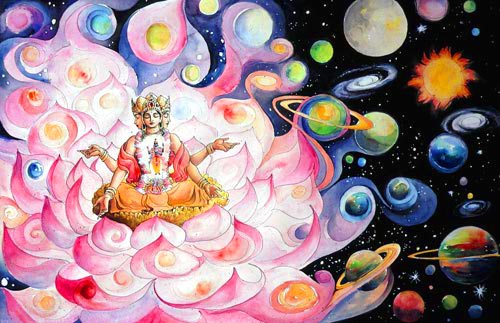How the universe was created – Hindu cosmology
“In the beginning there was neither existence nor non- existence; there was no atmosphere, no sky, and no realm beyond the sky. What power was there? Where was that power? Who was that power? Was it finite or infinite?
There was neither death nor immortality. There was nothing to distinguish night from day. There was no wind or breath. God alone breathed by his own energy. Other than God there was nothing.
In the beginning darkness was swathed in darkness. All was liquid and formless. God was clothed in emptiness.Then fire arose within God; and in the fire arose love. This was the seed of the soul. Sages have found this seed within their hearts; they have discovered that it is the bond between existence and non-existence.
Who really knows what happened? Who can describe it? How were things produced? Where was creation born? When the universe was created, the one became many. Who knows how this occurred?
Did creation happen at God’s command, or did it happen without his command? He looks down upon creation from the highest heaven. Only he knows the answer -or perhaps he does not know.”Rig Veda 10:129.1-7
With its cyclical notion of time, Hinduism teaches that the material world is created not once but repeatedly, time and time again. Additionally, this universe is considered to be one of many, all enclosed “like innumerable bubbles floating in space.”
The concept of eternal and cyclical time lies at the heart of the Hindu world view and is closely related to the concept of atman. (Hindu sages claim that the individual’s self-understanding determines his or her perception of the world.) Hindus consider the real self to be ever-existing, not only in the future but also from the past. This notion of two-way eternity, however, is not reserved solely for the realm of spirit (Brahman) but extends to this temporal world. Within Hinduism we find no “year dot,” nor a final cataclysm. The closing of one door implies the opening of another. Destruction of the cosmos only portends its re-creation. The entire material world is thus subject to everlasting cycles of creation, sustenance and destruction.
This universe is said to exist for a lifetime of Brahma, the creator. His one day is 1,000 maha-yugas (great ages). Each maha-yuga consists of four yugas (ages), each progressively shorter and more degraded. They are the golden, silver, copper, and iron ages. According to tradition, we have had just over 5,000 years of Kali-yuga and there remain 427,000 years. At the end, the final incarnation of Vishnu, Kalki, is scheduled to appear, heralding the dawn of yet another golden age.
Accounts of creation differ in many respects. As per Hindu mythology, Brahma was born from a (kamala) lotus springing from Vishnu’s navel and created the world through his daughter Saraswati. According to Manu Smriti, the self- existent Lord manifested to dispel the darkness enveloping universe. He created the waters and deposited a seed that became a golden egg from which he was born as Brahma. He divided the egg into two parts to construct the heaven and earth, and created the ten Prajapatis, mind-born sons, who completed the work of creation. By a third account, the Lord separated himself into two parts, the male and the female after dividing the golden egg. From him sprang Viraja and from him Manu. Ramayana states that Brahma sprang from the ether and that sages Marichi, Atri, Angiras, Narada, Sanaka, Sanandana, Sanatkumara, Sanasujata and others are his manasa putras (mentally conceived sons). From Marichi sprang Kashyapa from whom sprang Vishwavata who created Manu, the procreator of all human beings. Thus, Manu is Brahma’s great grandson.
Brahma is commonly represented as having four heads, four arms, and red skin. Unlike all the other Hindu gods, Brahma carries no weapon in his hands. He holds a water-pot, a spoon, a book of prayers or the Vedas, a rosary and sometimes a lotus. He sits on a lotus in the lotus pose and moves around on a white swan, possessing the magical ability to separate milk from a mixture of water and milk. Brahma is often depicted as having long white beard, with each of his heads reciting the four vedas.
Bibliography
http://hinduism.iskcon.org/concepts/111.htm
http://hinduism.iskcon.org/concepts/112.htm
http://www.eaglespace.com/spirit/brahma.php
http://hinduism.about.com/od/godsgoddesses/p/brahma.htm

